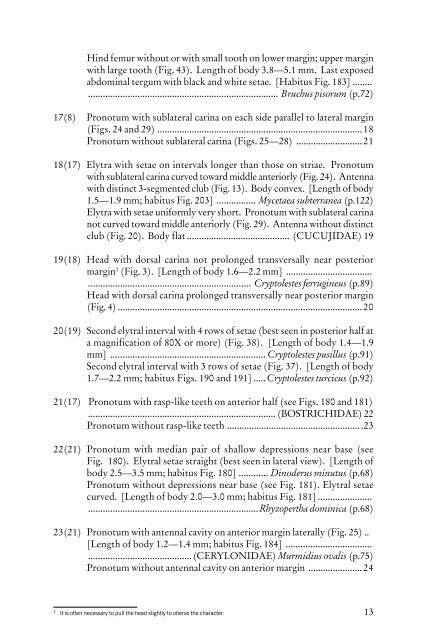Beetles Identification Guide
Beetles Identification Guide
Beetles Identification Guide
You also want an ePaper? Increase the reach of your titles
YUMPU automatically turns print PDFs into web optimized ePapers that Google loves.
Hind femur without or with small tooth on lower margin; upper margin<br />
with large tooth (Fig. 43). Length of body 3.8—5.1 mm. Last exposed<br />
abdominal tergum with black and white setae. [Habitus Fig. 183] ........<br />
............................................................................. Bruchus pisorum (p.72)<br />
17(8) Pronotum with sublateral carina on each side parallel to lateral margin<br />
(Figs. 24 and 29) ...................................................................................18<br />
Pronotum without sublateral carina (Figs. 25—28) ...........................21<br />
18(17) Elytra with setae on intervals longer than those on striae. Pronotum<br />
with sublateral carina curved toward middle anteriorly (Fig. 24). Antenna<br />
with distinct 3-segmented club (Fig. 13). Body convex. [Length of body<br />
1.5—1.9 mm; habitus Fig. 203] ................ Mycetaea subterranea (p.122)<br />
Elytra with setae uniformly very short. Pronotum with sublateral carina<br />
not curved toward middle anteriorly (Fig. 29). Antenna without distinct<br />
club (Fig. 20). Body flat .......................................... (CUCUJIDAE) 19<br />
19(18) Head with dorsal carina not prolonged transversally near posterior<br />
margin 1 (Fig. 3). [Length of body 1.6—2.2 mm] ...................................<br />
.................................................................. Cryptolestes ferrugineus (p.89)<br />
Head with dorsal carina prolonged transversally near posterior margin<br />
(Fig. 4) ...................................................................................................20<br />
20(19) Second elytral interval with 4 rows of setae (best seen in posterior half at<br />
a magnification of 80X or more) (Fig. 38). [Length of body 1.4—1.9<br />
mm] ............................................................... Cryptolestes pusillus (p.91)<br />
Second elytral interval with 3 rows of setae (Fig. 37). [Length of body<br />
1.7—2.2 mm; habitus Figs. 190 and 191] .....Cryptolestes turcicus (p.92)<br />
21(17) Pronotum with rasp-like teeth on anterior half (see Figs. 180 and 181)<br />
............................................................................ (BOSTRICHIDAE) 22<br />
Pronotum without rasp-like teeth ...................................................... .23<br />
22(21) Pronotum with median pair of shallow depressions near base (see<br />
Fig. 180). Elytral setae straight (best seen in lateral view). [Length of<br />
body 2.5—3.5 mm; habitus Fig. 180] ............ Dinoderus minutus (p.68)<br />
Pronotum without depressions near base (see Fig. 181). Elytral setae<br />
curved. [Length of body 2.0—3.0 mm; habitus Fig. 181] ......................<br />
.....................................................................Rhyzopertha dominica (p.68)<br />
23(21) Pronotum with antennal cavity on anterior margin laterally (Fig. 25) ..<br />
[Length of body 1.2—1.4 mm; habitus Fig. 184] ...................................<br />
..........................................(CERYLONIDAE) Murmidius ovalis (p.75)<br />
Pronotum without antennal cavity on anterior margin ......................24<br />
1 It is often necessary to pull the head slightly to oberve the character.<br />
13
















